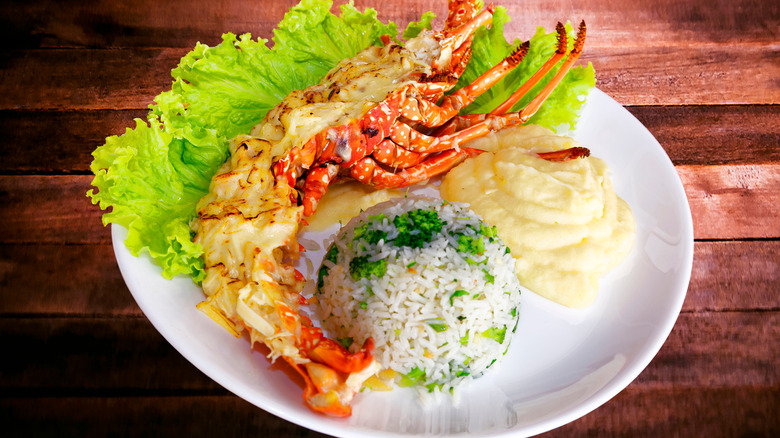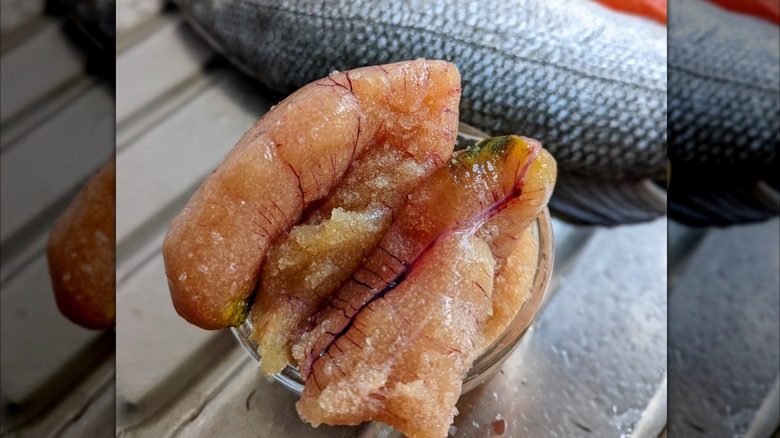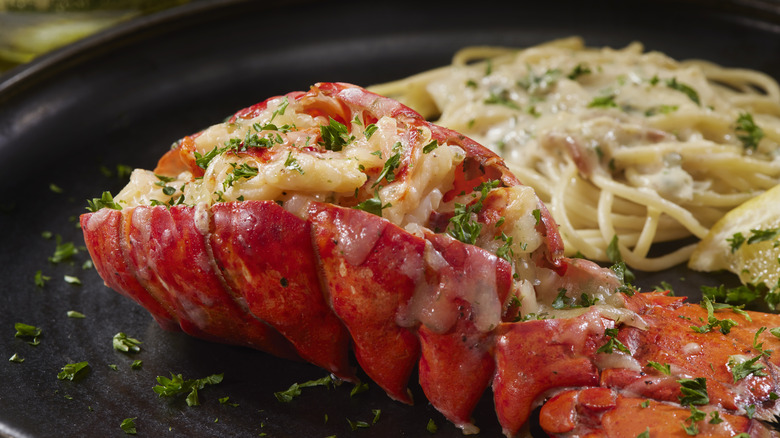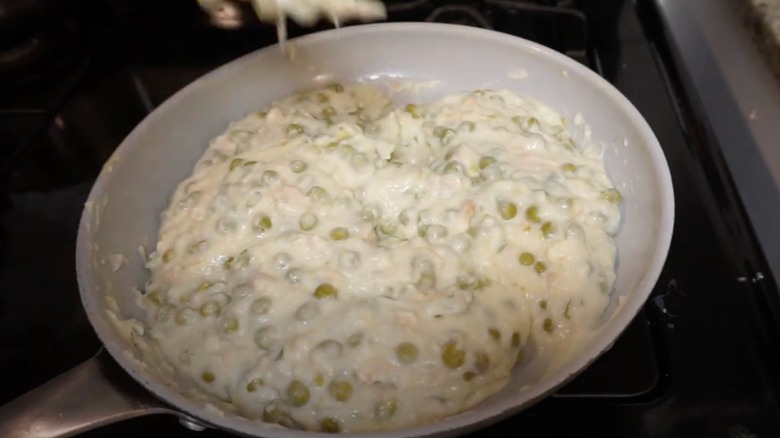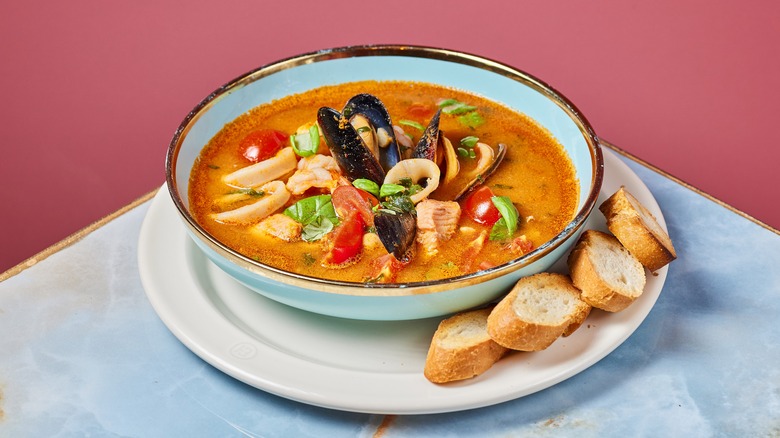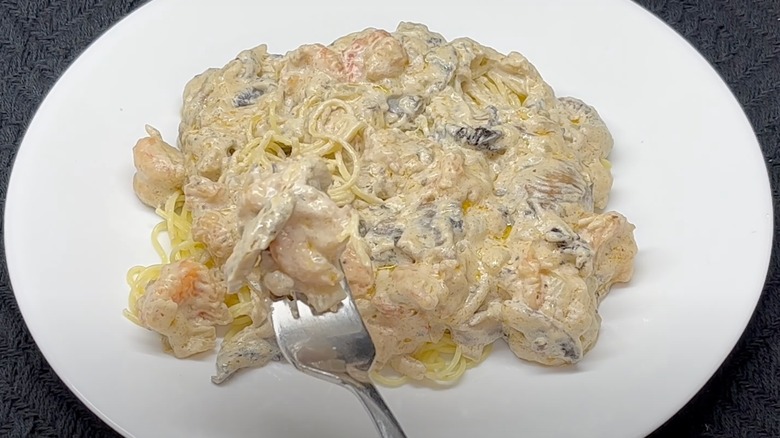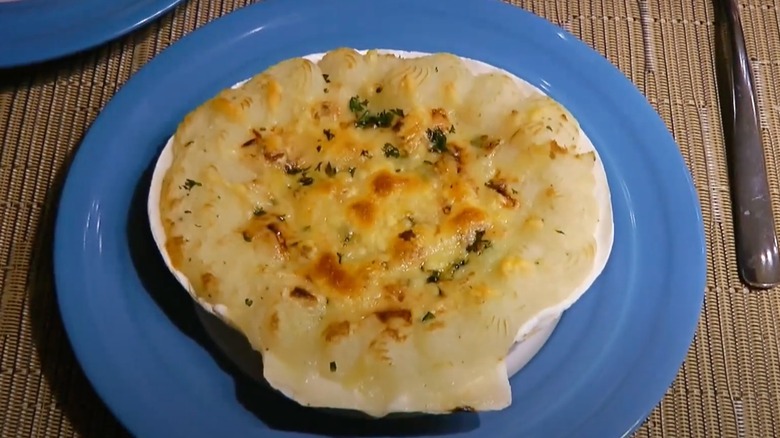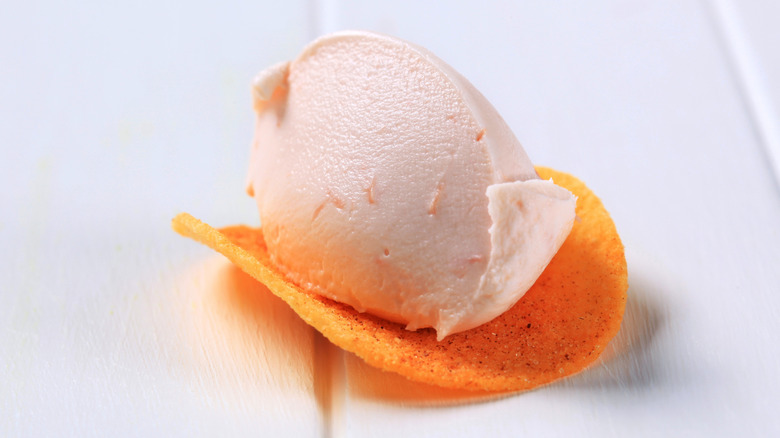Vintage Seafood Dishes That America Mostly Forgot
Seafood is a staple of countless American diets, but the type of seafood we've eaten throughout history has been influenced by food trends, availability, and sustainability. The kinds of fish that we may have enjoyed 100 years ago might be off-limits, whereas the sorts of dishes that people were drawn to on mid-century menus are now seen as retro. Plus, many seafood dishes in the 20th century forgot the most important thing about fish, lobster, and crab, which is that simple is often better.
In the 21st century, seafood generally looks minimal: We tend to like dishes that honor the taste of the protein in front of us. What did seafood dishes used to look like, though? Well, kinda interesting. In the past, Americans could be found eating delicacies like salmon mousse, creamed tuna and peas, and cheesy crab pie. In higher-end establishments, complicated dishes such as Lobster Newburg and Coquille St-Jacques ruled the roost. Diving into seafood history in the United States is a wild ride. Here's some old-school seafood dishes that many people have probably forgot about.
Lobster Newburg
Order lobster in any seafood restaurant these days, and it's likely to be served elegantly, with an emphasis on enjoying the flavor of the lobster and not muddying it with additional tastes. Things didn't always used to be this way. Back in the 19th and early 20th century, lobster dishes that combined its meat with other luxurious ingredients were all the rage — and Lobster Newburg was perhaps the most famous of them all.
Lobster Newburg is often said to have been invented in 1876 at Delmonico's, the very first steakhouse in the country. Back then, the dish was known as Lobster a la Wenburg, named after Ben Wenburg, the person who introduced it to the restaurant. Following an argument between Wenburg and Delmonico's proprietor Charles Delmonico, the dish was removed from the menu — but when customers complained, it was brought back under a different name. Soon, Lobster Newburg's popularity spread across the United States, and the dish is attributed with turning the seafood into the luxury item we know it today.
Lobster Newburg's appeal began to die as the 20th century rolled along, and the combination of cream, egg, cognac, and seafood began to be seen as outdated. It's pretty rare to find it anywhere nowadays. However, if you're willing to make the trip to Delmonico's, you can still order it from its menu, just as you could in 1876.
Crab pie
There are a lot of culinary rules out there, but one of the most famous ones is that you should never mix seafood and dairy. We're not sure whether we buy entirely into that belief, and if you were once a fan of crab pie, you probably don't either. Crab pie is a Northeastern specialty, with roots that are said to have started in Virginia. It was invented by none other than Martha Washington, the wife of George Washington and a rather underrated cookbook author.
This dish is basically exactly what it sounds like: A pie made with crab. More specifically, though, crabmeat is mixed with bread and eggs and then baked in a pie shell. Modern recipes incorporate ingredients like mayo, milk, flour, onions, peppers, and cheese. Crab pie has been enjoyed throughout the years in various forms in the Northeast, with some restaurants still serving it to this day, albeit in a more pizza-fied form. However, for most people, it's fair to say that the combo of crab and cheese feels a little old-school.
Shad roe
The history of shad, and shad roe, is pretty interesting. Shad is a fish that's rarely seen on menus these days, but at one point it was a heavily consumed seafood in the United States, and particularly popular in the Northeast. The fish is said to have been a favorite of George Washington, and a fortuitous run of shad in 1777 supplied the former president's troops with necessary food to keep on fighting, helping them to go on to be victorious in the Revolutionary War.
It's the roe, however, that became a beloved delicacy. Cooks would boil, smoke, or fry the roe to unlock its various flavors, augmenting it with butter to give it even more of a luxurious twist. Recipes for shad roe (and for shad) appeared in various cookbooks. However, as the 20th century marched on, shorelines were developed and tastes changed, and shad roe became way less of an attractive option. Although you can still buy it at a fishmonger's, it's only available for a few weeks each year.
Lobster Thermidor
As vintage seafood dishes go, Lobster Thermidor is the one you're most likely to have heard of. We'd wager that you probably haven't tried it, though, given that restaurants rarely sell it these days. The dish first appeared in the late 19th century, with its origin story coming in several different forms. Some people attribute its invention to chef Jean-Louis Vaudoyer at the Café de Paris, while others say it was created by Léopold Étienne Mourier, a cook who was inspired by the opening of the French revolution-inspired stage play "Thermidor," that was opening in the city at the time.
After a while, though, it didn't matter who invented it; what mattered was its flavor. The combo of lobster, mushrooms, Mornay sauce, wine, and a breadcrumb topping created an elegant and indulgent dish for Paris' social elite. As French cuisine became more popular in the United States at the start of the 20th century, Lobster Thermidor did too, and it was a feature on restaurant menus in New York and beyond. As with so many classic French dishes, however, Lobster Thermidor began to be seen as a little old-school, and new dishes got rid of the old classics. You can still find it in some fancier restaurants, but it's far from common these days.
Crab Louie
For folks who were eating at steakhouses in the mid-20th century, and wanted something light and fresh over a huge hunk of beef, there was one order that would always have their back. Crab Louie (also known as Crab Louis) is, in essence, a fairly simple crab salad. Although it was popular all over the country, it has a particularly strong foothold on the West Coast and specifically in San Francisco, where it's still known as one of the city's most famous culinary exports. The dish first appeared at the start of the 20th century in various cookbooks and on restaurant menus, and within a few decades it was a mainstay in steak joints and more established eateries.
Although Crab Louie is pretty easy to make, its appeal is all in the ingredients. By using the best crab, eggs, and cream possible, this dish elevates from being something you just throw together, and instead becomes an elegant salad. Unfortunately, there were as many bad Crab Louies out there as there were good ones, which perhaps contributed to its dip in popularity. If you're lucky enough to get a good one, though, you're in for a treat.
Creamed tuna and peas
While fish and creamy ingredients tend not to go together well, there's one exception to that rule. The taste of tuna typically pairs well with heavier, dairy-inflected flavors, as anyone who's ever tried a classic tuna salad sandwich will tell you. Back in the day, however, there was one recipe that took this combo to the next level. Creamed tuna and peas was a recipe that stemmed from the Great Depression (and may well have been around before then), and was prized for its ability to deliver a protein-rich, substantial, warming meal in minutes. It's basically a mixture of canned tuna and white sauce, with peas mixed in for good measure. The Depression was a time where people relied heavily on cost-effective canned foods to keep their bellies full, and we can see why this dish was so appealing at the time.
As the 20th century rolled on, canned tuna and peas became a thing of the past. The dish, which was often served on toast or biscuits, came to be seen as frugal and overly simplistic. This is the kind of dish that your grandma might still make, but you likely won't find it in any restaurants.
Bouillabaisse
Bouillabaisse is one of those French dishes that had a real moment in the United States — and then became a curio served only in select places. This Marseillaise fish stew was first invented out of necessity, with cooks needing to find a way to repurpose fish scraps into a filling meal. Soon, the piquant soup was being served in every restaurant across the dock. As with so many classic French meals, it eventually made its way to the United States. It rapidly became a go-to dish in French restaurants across major cities. However, the staff who worked in these restaurants would lament that they couldn't make it authentically due to their inability to source rascasse, a spiny fish traditional to Marseille-based bouillabaisse.
While bouillabaisse was served throughout the 20th century, it became a meal that started to feel like it was from a former era. Over time, all but the most traditional French restaurants got rid of the dish, perhaps because they realized they couldn't make it as well as they'd like. In major cities, you may find a bistro that serves it.
Shrimp Victoria
It's kinda wild that Shrimp Victoria has fallen out of favor, given how similar it is to other popular seafood dishes we still enjoy today. Shrimp Victoria is a dish that seems to have been enjoyed across the South, with particular popularity in New Orleans, where it was served in some of its most prominent restaurants. Its recipe was both passed from chef to chef and from home cook to home cook, with its simple ingredients and preparation making it easy to whip up quickly.
Shrimp Victoria can vary depending on the person making it, but at its root it's a combination of shrimp, mushrooms, parsley, and sour cream. Some folks like to make the sauce a little thicker by adding flour, while others like to make theirs spicier by throwing in Old Bay or hot sauce. The dish is typically served over hot steamed rice, although you could just as easily pile it onto toast. The bad news is that (as of this writing) the dish has been removed from the menus of the restaurants which would serve it across New Orleans, like Commander's Palace and Brennan's. The good news is that you can likely make a pretty good version for yourself at home.
Coquille St-Jacques
Sometimes, we encounter a vintage seafood dish that we know deserves a comeback. Today, that dish is Coquille St-Jacques. This French dish's name translates to "the shell of Saint James," and it's an elegant and delightful affair, consisting of gratinéed scallops served on their shell. The scallops are first poached in aromatic white wine before being placed back into their shells, which have already been filled with an umami-rich mushroom purée. They're doused with a cheesy white sauce and broiled until blistered on top. Tell us that doesn't sound delicious!
The name for Coquille St-Jacques comes from the tale of Saint James, a fisherman who according to Catholic convention was found in a shipwreck surrounded by scallops. As a result, the scallop shell has come to symbolize the saint. The dish, meanwhile, came to symbolize fine dining in New York in the 1950s, where it was a mainstay on menus in French restaurants. Eventually, Coquille St-Jacques became less popular and started to die out. We think that's a crying shame.
Salmon mousse
There are some vintage seafood dishes that we're happy not to see ever again. Salmon mousse is one of these. The retro dish to end all retro dishes, salmon mousse is the epitome of mid-century American cooking. Canned salmon (which is normally a pretty high quality canned fish) would be mixed with gelatin and heavy cream, as well as a host of flavor elements like Tabasco, paprika, dill, and lemon juice. The mixture was then crammed into a mold — the shape used was entirely the cook's choice: It could be a ring, a block, a loaf, or in the shape of a fish — left to set, and then served with crudités or on crackers.
Salmon mousse feels like a time capsule to a moment when food preparation was all about kitschy appearance, instead of actual flavor and a respect for the seafood being used. It's no surprise that this dish, which was once all over America, has since been banished to whence it came. There are some people who still advocate for salmon mousse, as well as mousses made with other fish — but to those people we say: Let's not.
